
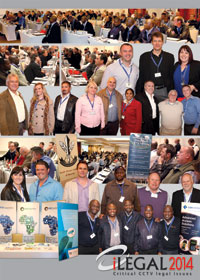
iLegal 2014 took place in August this year and was pronounced a success by all the attendees as well as the presenters. This year the conference once again looked at the legal responsibilities in meeting technical challenges, specifically but not exclusively focusing on realising the potential of CCTV.
As always, iLegal sported a sterling line-up of speakers, from one of the legal eagles involved in the formulation of the Protection of Personal Information (POPI) Act, through to the manager of a successful safe city project and a forensic security expert from a mine who used Six Sigma principles to optimise the organisation’s surveillance.
Francis Cronjé

The keynote was provided by Francis Cronjé, founder and MD at franciscronje.com, and CEO at InfoSeal. Cronjé spoke on the POPI Act and its implications from a legal perspective. He started by explaining that the act focuses on information and not information technology, which means that the data covered by POPI includes electronically stored information as well as paper records. In fact, information classified as personal, in whatever format, is affected by the act.
From the security perspective, this covers surveillance footage as well as access and intrusion data – such as the scrappy visitor’s book people fill in when entering a business premises. CCTV is one of the most information-intensive gathering and handling processes that exists and POPI goes to the core of what is being done by all of those involved with CCTV and security.
POPI was enacted in November last year, and as soon as a regulator is appointed, a commencement date will be announced. Businesses will have one year to comply, which may be extended to three years. He added that the regulations are not industry specific, which means industry bodies will have to formulate their own codes of conduct for their members. POPI is principle-based and is focused on an outcome, which means organisations will need to process all the information they collect by a defined set of rules.
Cronjé noted that POPI and the information it manages is not something to be left to a middle manager. The board is responsible to ensure that information is treated as a business asset, which means it must be identified and categorised. This involves identifying the information held and determining which data is personal, and then treating that according to the rules with respect to collecting, storing and destroying the information.
Each company will need to appoint a responsible person to ensure POPI compliance – a senior executive. This is because the company will be held responsible for breaches which see personal information compromised or not handled according to the rules. Even when outsourcing the handling of information to a remote third party, the organisation will still be held responsible if something goes wrong.
The securing of personal information is likely to create problems for companies using cloud services to store their data in the USA, for example, since the data is not secure from prying eyes. Additionally, the subject must give consent for the organisation to hold their data after being educated as to what it is for and how it will be handled. Children’s personal information may not be processed, which will also create problems for some companies.
Rob Anderson

Rob Anderson, MD of Rob Anderson & Associates was up next. Anderson took the legal issues presented by Cronjé and applied them to the security industry, looking at what information is collected on a daily basis and how it will have to be handled once POPI is in effect.
Anderson explained that security operations are impossible without collecting data, so POPI is definitely an applicable challenge for the industry. He also noted that data theft is not always obvious, as the data doesn’t actually vanish, it’s just copied. This requires an additional focus on how to secure information, which can be collected from video or voice recordings, an occurrence book, access control records, access control transactions, security system alarms and so forth.
In an access control application, for example, the following information can be collected: name, ID number, cell number, address, employer, car registration, access reason, fingerprint, photograph and more. Naturally, most, if not all of these data qualify as personal and will need protection. Moreover, it is not a case of simply storing it in a safe location, the lifespan of the information needs to be predetermined and it needs to be destroyed after a certain time – not “kept until it’s lost”. Once again, he stressed this also applies to paper-based information; simply throwing records into the bin will not be acceptable.
Anderson also voiced caution at the increasingly common practice of hosting data in the cloud, reminding the audience that the primary responsibility for data collected is the organisation collecting it, not the third party hosting it.
Furthermore, he also explained that what’s different about POPI is that someone needs to be appointed to take the blame. It won’t just be a company that is fined or sanctioned, but senior people within the company, which makes compliance with the regulations more important than ever (for those senior executives).
South African companies are inclined to skirt regulations and look for a short cut because of the lack of enforcement in terms of compliance. With POPI, this will change and the people responsible for shortcuts, i.e. the directors and owners will be the ones called to account.
Andrew Seldon
Andrew Seldon, editor of Hi-Tech Security Solutions followed with a look at the potential impact of emerging security technologies. The presentation was not focused on the coolest technology out there, but rather at technology that is adding or will add value to security installations in the near future.
The technologies discussed included 4K surveillance, new HD cameras that offer 4-times the resolution of current HD (1080p) systems. These systems will see a growing market in 2015 or 2016, but are going to be installed in specific areas where broad surveillance is required. However, people using 4K systems need to be aware of the increased bandwidth required to transmit these video streams. The emergence of security’s own Big Data problem was also mentioned as companies are faced with the issue of developing more ways to analyse enormous amounts of security data to extract intelligence for security and other areas of the business.
Thermal cameras made it into this roundup, even though they don’t qualify as ‘new’ technology. As the prices keep declining and more companies offer thermal solutions, we will see more of these devices in the market in areas where 24x7 surveillance is important. Mobile access is also a growing feature of security solutions as the ability to view and manage systems via a mobile app makes for convenience and higher productivity – with the normal warnings of jamming and bandwidth costs.
Other notable mentions in terms of technology included analogue HD solutions, edge storage, body-worn cameras and hosted video solutions. On a more non-technology note, the presentation also highlighted how integration and open systems are going to become much more important than ever and deliver a way in which security can make an impact on other areas of the business and help them deliver measurable returns.
Finally, the Internet of (security) Things was mentioned as an enormous challenge going forward, but also an enormous opportunity.
Lucas Holtzhausen
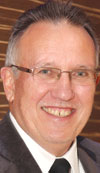
Lucas Holtzhausen, general manager of Safe City Msunduzi was up next highlighting some of the key success factors in effective city surveillance.
Safe City Msunduzi was set up under the jurisdiction of the Pietermaritzburg Municipality to assist the SA Police Service and the Municipality in law enforcement. The goal was to encourage a crime free environment that would benefit the city’s communities and attract investors and promote development, tourism and job creation. The municipality was faced with the same problems all South African municipalities face, lower number of police members and an increase in crime, and this led to a study into the feasibility of the safe city project in 1999.
While there is a substantial technology component to the safe city, Holtzhausen says the long-term success of the project is the result of the cooperation and hard work from all the partners of Safe City Msunduzi: the Msunduzi Municipality, the National Prosecuting Authority, Business Fighting Crime and the SAPS.
Msunduzi Municipality provides the capital and operating funding as well as security and traffic response teams, while having officers on duty in the control room. A SAPS member is in the control room all the time and provides rapid response to incidents as well as daily crime intelligence reports. The National Prosecuting Authority has provided a dedicated CCTV court that has a DVD and a large monitor for trials. Business Fighting Crime is a link between the safe city project and the business community and funds ad hoc functions.
The project is intelligence and target driven and invests in its operators’ training to ensure they meet their targets – operators that exceed their targets are financially rewarded. It also contributes 95% of staff medical aid fees among other benefits to ensure the welfare and commitment of staff. Technical support is also done in-house by trained technicians.
Holtzhausen said that the success and longevity of Safe City Msunduzi is due to its autonomous control, direction, operations and responsive decisions followed by effective action.
Howard Griffiths
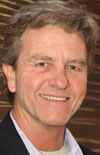
Howard Griffiths, MD of Security Service Consultants (SSC) delivered an interesting presentation on body-worn cameras. SSC does not sell these devices but has found them to be beneficial to its guarding services. Griffiths says body-worn cameras are a silent witness to activities, not only in a security context, but also in other business areas such as labour, occupational health and safety and productivity.
These systems allow companies to regulate the behaviour of their guards as well as people they interact with, as everyone seems to behave better when they know they are on camera. They also allow for capturing crucial crime scene evidence and witness interviews almost immediately.
Despite the usefulness of these devices, he noted that the legislation concerning their use has not been finalised and issues such as their use in labour disputes and civilian versus police operations has yet to be clearly defined. It’s also important to note that the technology is only one component of the solution as the user needs to be competent in its operation and the back-end servers and evidence collection processes and technologies also need to be effective and managed effectively.
Of course, these systems have areas in which their operation will not add much value and may even cause an adverse reaction. Griffiths therefore suggested that the areas in which they would be best applied include:
* Armed response
* CCTV patrol units
* Riot control
* Policing
* Hospitality and events
* Interviews and hearings
* Health and safety
Pieter Swanepoel

Pieter Swanepoel is a project manager at Fidelity Security Services and he spoke on the dynamics of remote vehicle surveillance. Swanepoel said the application of remote vehicle surveillance has two goals, the first is to detect and prove criminal behaviour, the second to manage driver behaviour. He was able to speak from Fidelity’s own experience with in-vehicle surveillance, a process that has succeeded after some initial problems. The company has had good results using its in-vehicle cameras in the capture and prosecution of multiple criminals who were clearly identified in the commission of their crimes.
The company went through many DVR technology options before settling on its current systems because of the difficulty in finding mobile DVRs that were up to the task. Some of the issues he considers critical in a DVR include finding one that is distributed and supported locally, is robust and reliable enough to handle spending time on the road, low power consumption and good image quality. Fidelity’s current solution can control up to four cameras per car, has 500 GB onboard storage and can transmit images back to the central servers via 3G or WiFi.
The successful application of this type of remote surveillance requires more than technology, however, Swanepoel says the following components are required: technology, facilities, organisational structure, maintenance and process flow. Without these as an integrated process, the whole project could hit serious snags.
Swanepoel included videos of Fidelity’s success stories in his presentation, showing the value that efficient in-vehicle surveillance offers.
Kevin van Zyl

Kevin van Zyl, divisional manager: Security: Process and Sustainability Division at Lonmin Platinum demonstrated how process improvement is effective in taking security performance delivery to the next level.
Van Zyl started his presentation by stating that the concept surveillance includes “the ability to detect process variation”. At Lonmin, this meant using Six Sigma to devise a process of improvement in various stages to optimise its surveillance system – along with other sources of information – in an effort to improve processes and reduce loss.
The project followed different phases (define, measure, analyse, improve and control) to set a base of what the company’s losses and detection rates due to CCTV were to start the process improvement, and a data-driven security monitoring. Following the lengthy cycle of improvement, the results proved the viability of Van Zyl’s method as losses were drastically reduced and remain firmly under control.
Despite the technology and processes involved in the improvements in loss control, Van Zyl ended by noting, “the key ingredient to success is dedicated, hard working, loyal people with exceptional levels of integrity. Without them this exercise would be futile.”
Gus Brecher
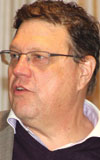
Gus Brecher, MD of Cathexis Technologies followed, addressing the topic of integration and how integrating your security technology delivers value to security and other areas of the organisation. He noted that it is a common occurrence for security professionals to have to deal with budgets that don’t cover all the security solutions they need, forcing them to compromise in some areas.
Brecher defines integration as being able to receive information from multiple systems and make automated, informed decisions based on the data collected. By extending the scope of your security systems to collect and analyse this information, your budget can be boosted with funds from other areas of the business, which will pay for the information they can get out of it because it benefits them and assist them in reaching their goals.
An example is the integration of intruder and fence alarm systems. Instead of having people monitoring perimeters via cameras or guard patrols, intelligent systems will know where an alarm is and automatically bring the right camera up in the control room so that the correct, effective action can be taken. This leads to increased efficiency and accuracy of the company’s operations and an increased return on investment (ROI).
A similar result is obtainable when integrating access control and time & attendance, shrinkage control at retail POS points, people counting, queue management and heat maps in retail (using the organisation’s security cameras to automatically provide this information as well as normal security functions), as well as in logistics and plant management functions and more.
Brecher’s message was that security systems can be used to deliver a measurable return to different areas within a company if they are implemented correctly and integrated to allow for a single information store that can be analysed and mined. ROI results when data is intelligently analysed to deliver business intelligence that adds value.
Dr Craig Donald
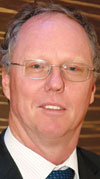
Dr Craig Donald, MD of Leaderware and co-host of iLegal closed the day’s proceedings with a presentation focused on the integration of technology and human factors in what he termed Smart Surveillance.
Donald said that we often see control room solutions advertised as being able to reduce the number of operators employed or increase the productivity of the operators. While technology is a great benefit to surveillance, it cannot replace the benefits obtained by properly trained human resources. Smart surveillance requires a combination of both people and technology and covers the surveillance task by offering the following:
* Recognition
* Interpretation
* Decision making
* Identification
* Association
* Reporting
Accomplishing these functions goes beyond what humans or technology can do alone, they need to work together to deliver value. Where technology can add value is in areas such as functional replacement, background sensing and alerts/alarms, early warning systems, information management and automated delivery and the verification of operator performance, among others.
Another contentious issue is that in many instances technology and operators are deployed without any real idea as to what they are supposed to accomplish. The solution is to start with a clear purpose for your CCTV installation and then develop the systems and people to support this purpose.
Prizes galore

The day ended with a lucky draw that saw a few attendees receiving prizes from The Consumer Goods Council Risk Initiative (CGCRI) as well as ZKTeco.
The prize from the CGCRI was a copy of its valued Recommended CCTV Industry Guidelines handbook, a publication designed to assist in the design and implementation of surveillance systems. Copies of this handbook can be ordered by downloading the form at http://www.cgccrime.org.za/media/docs/CCTV_Industry_Guideline_Order_Form.doc.
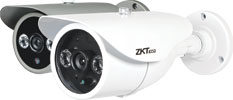
ZKTeco offered a host of high-value technology prizes to five different winners. The prizes handed out included:
* A 4-channel DVR with 720p Recording,
* Two Galaxy Dome cameras with 1280x720 resolution, and
* Two Galaxy Bullet cameras also sporting 1280x720 resolution.
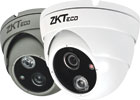
ZKTeco said it provided the chosen cameras because iLegal focuses primarily on surveillance and the items provided would fit well into an indoor surveillance project for small businesses or homes – or anywhere a network is present.
Exhibitors’ comments
As can be seen from the images, iLegal 2014 was privileged to host a few exhibitors in the main hall who were able to interact with the attendees during breaks. Hi-Tech Security Solutions asked what their impressions of the event were.
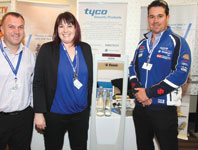
Anjula Jagesur from Tyco said the company’s exhibit was a broad overview of Tyco, representing three different divisions: Tyco Retail Solutions Division with the Sensormatic EAS brand, the Commercial division Tyco Integrated Fire and Security, as well as Tyco Security Products and the brands it represents in South Africa, like American Dynamics, CEM and more.
Jagesur added that the conference was well organised with a great venue and location. “It was great to have our display table in the room where the delegates were sitting so they could see our brands displayed at all times . . . The subjects were relevant and informative.”
When asked which trends and products are most relevant to the surveillance world, Jagesur offered the following:
IP: The switch from analogue to IP surveillance brings significantly more functionality into CCTV, for example true enterprise wide surveillance spanning multiple locations cities or even continents, ‘at-the-edge’ recording, video analytics and even tighter integration with other security systems and even business processes. These days, more progressive security operators are integrating IP cameras seamlessly into existing business-intelligence applications via open-platform infrastructure.
High definition: Since the dawn of HDTV, mainly driven by the consumer electronics market with its shift from CRT-based televisions to more modern LCD, plasma and new LED-based TV screens, HDTV is becoming very popular for IP surveillance cameras and today clients can have systems with1, 2, 4 or even 32 megapixel cameras.
Mobility: With the advent of mobile computers, smartphones and tablets, security solutions have been adapted for mobile use in order to make it possible to view surveillance video anywhere, at any time, with image sizes and file bandwidth flexible enough to accommodate varying usage.
Thermal imaging cameras: As the price of thermal imaging cameras continues to fall these devices are being used more in commercial applications. Thermal imaging cameras give security operators the ability to ‘see’ threats that are not visible to the naked eye by making images from the heat energy that is around us all the time, not from reflected visible light. This then allows for true 24/7 imaging capability without lights or illuminators.
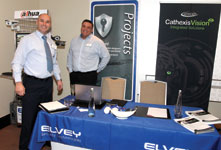
Robin Lithgow from Elvey Security Solutions was one of the people on the Elvey stand and he found the event to be very well attended and well organised. Elvey had a host of products on display, including Dahua HD-CVI cameras, Arecont Vision megapixel cameras and VisionLine IP cameras. When asked what he sees as the major trends going forward, Lithgow said megapixel IP cameras and interactive alarm services were the areas to watch.
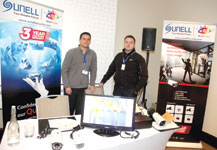
Sunell was also on display with MJ Oosthuizen saying, “iLegal is an important event on the security calendar which is overlooked by various key players in the market. The information and opinions shared adds value to all players within the surveillance industry, and this year was no different to the previous sessions.”
Sunell showcased its IP thermal and megapixel camera offerings, which have gained enormous ground over the past few months within the local market. The company is focused on quality of image and quality of hardware, which accounts for its rapid growth.
In his opinion, the major trends in surveillance will be an increase in demand for affordable and more intelligent video offerings. “IP video comes in all shapes and sizes these days, but we are seeing a massive demand and drive for affordability in the uncooled thermal camera segment.”
| Tel: | +27 11 543 5800 |
| Email: | [email protected] |
| www: | www.technews.co.za |
| Articles: | More information and articles about Technews Publishing |

© Technews Publishing (Pty) Ltd. | All Rights Reserved.